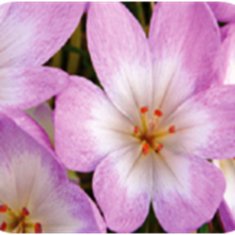Houston’s Best Pet Sitters: Top 10 Plants Toxic to Pets

March 17 kicks off National Poison Prevention Week. I did a quick search to find poisonous-to-pets plants I am not familiar with. There were hundreds! However, only a small percentage of plants are truly dangerous and poisonous to your pet. Make sure you know which plants are most deadly to avoid your dog or cat getting into them. Thank you to the Pet Poison Helpline for publishing the Top 10. Here they are.
There are two Crocus plants: one that blooms in the spring and the other in the autumn. The spring plants are more common. These can cause general gastrointestinal upset including vomiting and diarrhea. Autumn Crocus is highly toxic and can cause severe vomiting, gastrointestinal bleeding, liver and kidney damage, and respiratory failure.
Azaleas can have serious effects on pets. Eating even a few leaves can result in vomiting, diarrhea and excessive drooling; without immediate veterinary attention, the pet could fall into a coma and possibly die.
The roots of this flowering plant are especially dangerous to pets. If ingested, cyclamen can cause severe vomiting and even death.
This flowering plant can cause vomiting, diarrhea and heart arrhythmias if ingested by pets.
There are dangerous and benign lilies out there. Peace, Peruvian, and Calla lilies can cause minor problems, such as irritation to the mouth, tongue, pharynx, and esophagus – this results in minor drooling. The more dangerous, potentially fatal lilies are true lilies. These include Tiger, Day, Asiatic, Easter and Japanese Show lilies – all of which are highly toxic to cats. Even ingesting 2-3 petals or leaves can result in severe kidney failure. If your cat is seen consuming any part of a lily, take your cat (and the plant) immediately to a veterinarian for medical care. Decontamination (like inducing vomiting and giving binders like activated charcoal) are imperative in the early toxic stage, while aggressive intravenous fluid therapy, kidney function monitoring tests, and supportive care can greatly improve the prognosis.
Oleander is a very popular evergreen shrub with delicate flowers. However, the leaves and flowers are extremely toxic if ingested and can cause severe vomiting, slow the heart rate and possibly even cause death.
Dieffenbachia
Dieffenbachia can cause intense oral irritation, drooling, nausea, vomiting and difficulty swallowing if ingested.
Ingestion of the bulb, plant or flower can cause severe vomiting, diarrhea, abdominal pain, and possible cardiac arrhythmias or respiratory depression. Crystals found in the outer layer of the bulbs cause severe tissue irritation and drooling. Daffodil ingestion can result in more severe symptoms.
Symptoms include vomiting, diarrhea, a drop in heart rate, severe cardiac arrhythmias, and possibly seizures.
If ingested, the leaves and seeds can cause vomiting, bloody stools, damage to the stomach lining, severe liver failure and, in some cases, death.
The toxic principle of these plants is very concentrated in the bulbs (versus the leaf or flower), so make sure your dog isn’t digging up the bulbs in the garden. When the plant parts or bulbs are chewed or ingested, it can result in tissue irritation to the mouth and esophagus. Typical signs include profuse drooling, vomiting, diarrhea, depending on the amount consumed. There’s no specific antidote, but with supportive care from the veterinarian (including rinsing the mouth, anti-vomiting medication, and possibly subcutaneous fluids), animals do quite well. With large ingestions of the bulb, more severe symptoms such as an increase in heart rate and changes in respiration can be seen.
This is only a partial list of poisonous plants. If you suspect your pet has ingested any of these items or any other questionable substance, call Pet Poison Helpline or your veterinarian for assistance.
